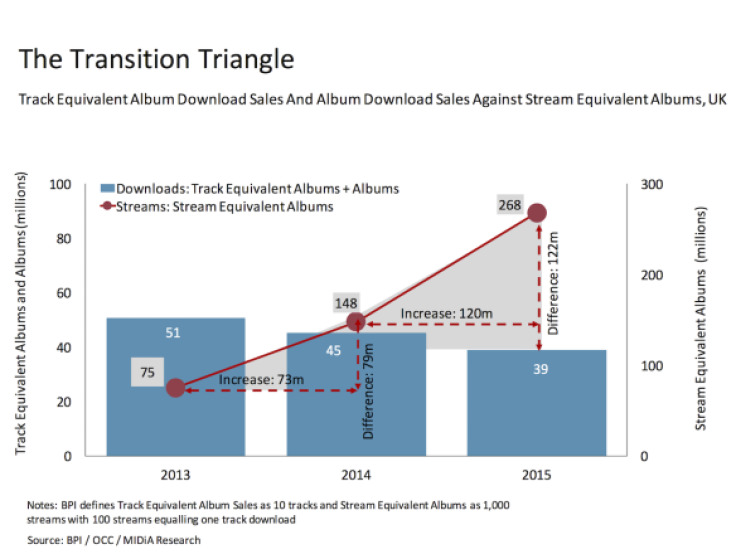Music Streaming Grew In The US And UK At A Nearly Identical Pace In 2015

Nearly identical leaps in streaming fueled modest growth in two of the world’s largest music markets in 2015. The British Phonographic industry revealed Wednesday that British consumers streamed 26.8 billion songs in 2015, an 82 percent increase from the 14.8 billion streamed in 2014. Separately, Nielsen announced that U.S. listeners fired up 144.9 billion song streams in 2015, 83 percent more than the 2014 total. The United States is the world's largest music market; Britain is the fourth, according to the International Federation of Phonographic Industries.
The rise of consumption in Britain was boosted by an accounting quirk, which added an extra week’s worth of sales data to the figures. Nevertheless, streaming remained the story. The money generated from streams via subscription-supported services like Apple Music, Spotify and Deezer accounted for more than one-fifth of the total music consumed. Two years ago, streaming accounted for just seven percent of music consumption in Britain. The gains in streaming were a major reason why both markets experienced growth in consumption: In Britain, consumption rose 4 percent, while in the U.S., it rose 13 percent.
Sliding Downloads
Both reports contained bad news, too. Both album and individual track sales declined again, though the slide for individual tracks was far more pronounced. In the U.S., digital track sales fell more than 12 percent, to $965 million, less than a decade after the industry had started getting used to the idea that individual track sales could account for billion-dollar revenues. In Britain, track sales slid nearly 14 percent, to 390 million songs sold.
Those slides represent the latest evidence that streaming is killing the market for individual downloads. While plenty of music consumers still feel compelled to pay full freight to listen to a full album, far fewer people appear compelled to pay 99 cents to buy a song from iTunes or a similar source.
“The market data is now becoming unequivocal,” MIDiA Research founder Mark Mulligan wrote in a blog post examining the BPI's findings. “The difference in volumes between downloads and streams each year is almost exactly the same as the amount by which downloads decreased the previous year. At this point even the most ardent replacement theory sceptic might start suspecting there’s at least some degree of causality at play.”

Looking Up At Video
For all that, audio streaming gains were outpaced by the growth of streaming music video in both markets. In the U.S., Nielsen found that streaming video growth, which it arrived it by looking at streams on YouTube, VEVO and AOL, discovered that video growth exceeded 101 percent. In Britain, the year-over-year growth was 88 percent.
"However good a job the streaming services might be doing of growing their market, YouTube is doing an even better one," Mulligan wrote.
Hello, Hello
Separate from the streaming surges, a handful of releases dominated the album sales landscape, none bigger than Adele’s “25.” Nielsen noted that the album sold 3.37 million copies in its first week, the largest first week total ever and far more than the 2.4 million sold by the previous record holder, NSync’s “No Strings Attached.” It’s sold 15 million copies worldwide.
Those record-smashing numbers may have been aided by Adele’s decision not to stream her anxiously awaited album on any services.
© Copyright IBTimes 2024. All rights reserved.











